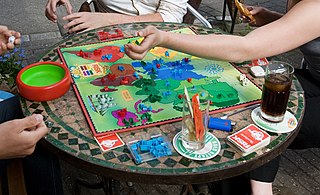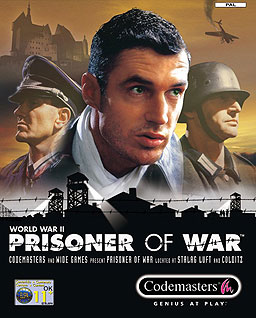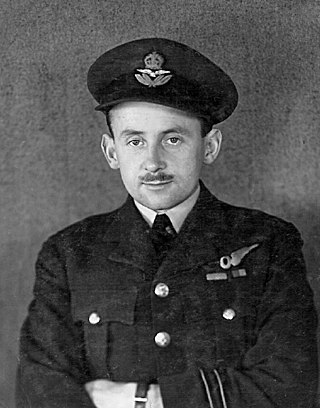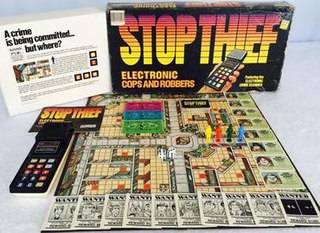
Risk is a strategy board game of diplomacy, conflict and conquest for two to six players. The standard version is played on a board depicting a political map of the world, divided into 42 territories, which are grouped into six continents. Turns rotate among players who control armies of playing pieces with which they attempt to capture territories from other players, with results determined by dice rolls. Players may form and dissolve alliances during the course of the game. The goal of the game is to occupy every territory on the board and, in doing so, eliminate the other players. The game can be lengthy, requiring several hours to multiple days to finish. European versions are structured so that each player has a limited "secret mission" objective that shortens the game.

Kill Doctor Lucky is a humorous board game designed by James Ernest and released in 1996 by Cheapass Games. In 1998, Kill Doctor Lucky won the Origins Award for Best Abstract Board Game of 1997.

Castle Colditz is a Renaissance castle in the town of Colditz near Leipzig, Dresden and Chemnitz in the state of Saxony in Germany. The castle is between the towns of Hartha and Grimma on a hill spur over the river Zwickauer Mulde, a tributary of the River Elbe. It had the first wildlife park in Germany when, during 1523, the castle park was converted into one of the largest menageries in Europe.

The Colditz Story is a 1955 British prisoner of war film starring John Mills and Eric Portman and directed by Guy Hamilton. It is based on the 1952 memoir written by Pat Reid, a British army officer who was imprisoned in Oflag IV-C, Colditz Castle, in Germany during the Second World War and who was the Escape Officer for British POWs within the castle.
Patrick Robert Reid, was a British Army officer and author of history. As a British prisoner of war during the Second World War, he was held captive at Colditz Castle when it was designated Oflag IV-C. Reid was one of the few to escape from Colditz, crossing the border into neutral Switzerland in late 1942.

Colditz is a British television drama series co-produced by the BBC and Universal Studios and screened between 1972 and 1974.
Which Witch? is a children's board game published in 1970 by the Milton Bradley Company, and was invented by Joseph M. Burck of Marvin Glass and Associates. The board represents a haunted house with four large rooms: the Broom Room, the Witchin' Kitchen, the Spell Cell and the Bat's Ballroom, assembled before play into a three-dimensional model house with vertical walls, and a large plastic chimney in the center. There are four tokens, colored red, yellow, blue and green. Each token is shaped like a child, either a boy or a girl, with four corresponding mouse tokens of identical color.

Oflag IV-C, often referred to by its location at Colditz Castle, overlooking Colditz, Saxony, was one of the most noted German Army prisoner-of-war camps for captured enemy officers during World War II; Oflag is a shortening of Offizierslager, meaning "officers' camp".

Prisoner of War is a 2002 third-person stealth video game developed by Wide Games and published by Codemasters. It follows the story of Captain Lewis Stone, a downed American pilot who must escape numerous prisoner of war camps and return home.
Prisoners made numerous attempts to escape from Oflag IV-C, one of the most famous German Army prisoner-of-war camps for officers in World War II. Between 30 and 36 men succeeded in their attempts - exact numbers differ between German and Allied sources. The camp was situated in Colditz Castle, perched on a cliff overlooking the town of Colditz in Saxony.

The Colditz Cock was a glider built by British prisoners of war during World War II for an escape attempt from Oflag IV-C prison camp in Germany.
A number of related games under the Yahtzee brand have been produced. They all commonly use dice as the primary tool for game play, but all differ generally. As Yahtzee itself has been sold since 1954, the variants released over the years are more recent in comparison, with the oldest one, Triple Yahtzee, developed in 1972, eighteen years after the introduction of the parent game.

A game is a structured form of play, usually undertaken for entertainment or fun, and sometimes used as an educational tool. Many games are also considered to be work or art.

Dominic Bruce, was a British Royal Air Force officer, known as the "Medium Sized Man." He has been described as "the most ingenious escaper" of the Second World War. He made seventeen attempts at escaping from POW camps, including several attempts to escape from Colditz Castle, a castle that housed prisoners of war "deemed incorrigible".

Stop Thief is an American-originated electronic board game published by Parker Brothers. It was released in 1979. In 2016, Restoration Games announced that they were bringing back a restored version of the game, using a free smartphone companion app in place of the electronic device. On April 11, 2017, they successfully funded a Kickstarter campaign for the game.

Freedom: The Underground Railroad is a 2013 co-operative board game designed by Brian Mayer and published by Academy Games, their first game in the Freedom Series. The game has drawn positive attention for its approach and handling of the topic.
Fireside Games is a US based board game publishing company owned and operated by Justin De Witt and Anne-Marie De Witt. Based in Austin, Texas, the company was founded in 2007. They published their first game, Castle Panic in 2009, and have published several expansions and sequels as well as other titles since then.
Hexagony is an abstract strategy board game for 2 to 6 players that was published as Bin'Fa by Taoist Arts Inc. in 1977, as Hexagony by Avalon Hill in 1980, and later re-released in a slightly modified form by Kenterprises as Bin'Fa.
Cluedo, known as Clue in North America, is a murder mystery-themed multimedia franchise started in 1949 with the manufacture of the Cluedo board game. The franchise has since expanded to film, television game shows, book series, computer games, board game spinoffs, a comic, a play, a musical, jigsaws, card games, and other media.

The Last of Us: Escape the Dark is an upcoming tabletop role-playing game published by Themeborne. Based on Naughty Dog's video game The Last of Us, the tabletop game was developed in partnership with Naughty Dog as an extension of Themeborne's Escape the Dark games. The game allows up to five players to control characters from The Last of Us. The goal is to reach safety from enemies while exploring locations from the game. Themeborne announced the game in November 2022; it was funded through a Kickstarter campaign, and is due for release in December 2023.
















